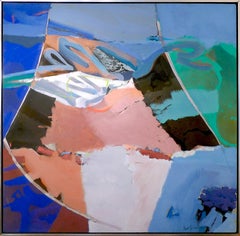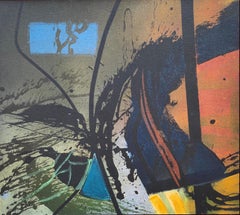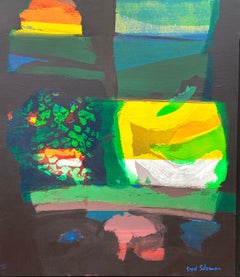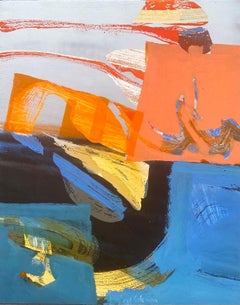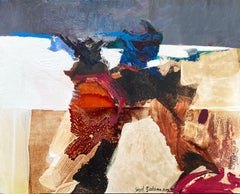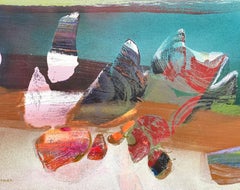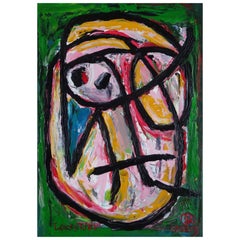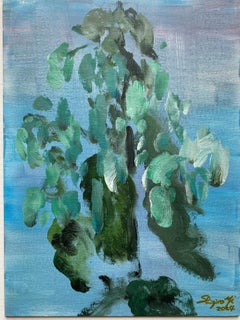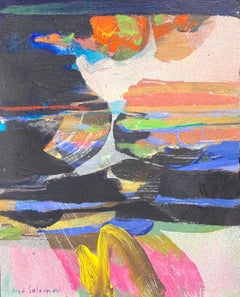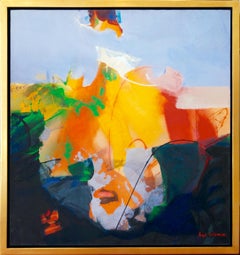Syd Solomon Paintings
American, 1917-2004
The following is from "Syd Solomon: A Retrospective Showing" exhibited at John and Mable Ringling Museum of Art and New York Cultural Center in 1975.
Born Uniontown, PA 1917 Education: Art Institute of Chicago; L'Ecole des Beaux Arts in Paris.
Teaching: Pittsburgh Art Institute; Ringling Museum of Art; Sarasota School of Art; Famous Artists School; New College in Sarasota; Visiting Instructor at University of Illinois in Urbana; Visiting Professor at Roberson Center for the Arts in Binghamton, NY; Visiting Artist at Tampa Bay Art Center.
Awards: Wrote and directed original play "Off Limits", which toured in France, Belgium and Luxembourg during 1945; State Department U.S. Cultural Exchange program to Israel; Ford Foundation Special Purchase Grant for the Guggenheim Musuem.
Exhibitions: Many exhibits from 1944 including Clearwater Museum of Art in Clearwater, FL; Lowe Art Gallery in Coral Gables; Associated American Artists Galleries; Saidenberg Gallery in New York; Midtown Gallery; Trend House Gallery in Florida; Brevard College; Paintings of the Circus at Sarasota Art Association; Annual Exhibition at the American Water Color Society 1955; Fifty Ninth Annual Exhibition at the National Collection of Fine Arts, Smithsonian 1956; Invitational Exhibition at the American Academy of Arts and Letters in 1959; Whitney Museum of American Art in 1964; Colorado Springs Fine Arts Center.
Collections: Adelphi University; Baltimore Museum of Art; Chrysler Art Museum; Guggenheim Museum; High Museum of Art; New Orleans Museum of Art; Wadsworth Museum; Whitney Museum of American Art; Witte Memorial Museum.to
4
1
2
Overall Width
to
Overall Height
to
7
1
4
1
7
3
3
1
7
5
5
5
5
9
780
713
712
687
7
7
Artist: Syd Solomon
Baytop
By Syd Solomon
Located in New York, NY
Signed lower right
Syd Solomon, an influential American artist known for his pioneering use of acrylic paint, began his artistic journey in high school in Wilkes-Barre, Pennsylvania...
Category
20th Century Abstract Syd Solomon Paintings
Materials
Canvas, Acrylic
$69,500
“Gulfside”
By Syd Solomon
Located in Southampton, NY
Original, oil paint and acrylic paint on canvas by the well known American artist, Syd Solomon. Signed bottom middle by the artist. Titled and dated verso 1983. Condition is excellent. Original gallery floating frame. Overall framed measurements are 38 by 42 inches. Provenance: A Sarasota, Florida collector.
SYD SOLOMON BIOGRAPHY
Written by Dr. Lisa Peters/Berry Campbell Gallery
“Here, in simple English, is what Syd Solomon does: He meditates. He connects his hand and paintbrush to the deeper, quieter, more mysterious parts of his mind- and he paints pictures of what he sees and feels down there.”
--Kurt Vonnegut Jr. from Palm Sunday, 1981
Syd Solomon was born near Uniontown, Pennsylvania, in 1917. He began painting in high school in Wilkes-Barre, where he was also a star football player. After high school, he worked in advertising and took classes at the Art Institute of Chicago. Before the attack on Pearl Harbor, he joined the war effort and was assigned to the First Camouflage Battalion, the 924th Engineer Aviation Regiment of the US Army. He used his artistic skills to create camouflage instruction manuals utilized throughout the Army. He married Ann Francine Cohen in late 1941. Soon thereafter, in early 1942, the couple moved to Fort Ord in California where he was sent to camouflage the coast to protect it from possible aerial bombings. Sent overseas in 1943, Solomon did aerial reconnaissance over Holland. Solomon was sent to Normandy early in the invasion where his camouflage designs provided protective concealment for the transport of supplies for men who had broken through the enemy line. Solomon was considered one of the best camoufleurs in the Army, receiving among other commendations, five bronze stars. Solomon often remarked that his camouflage experience during World War II influenced his ideas about abstract art. At the end of the War, he attended the École des Beaux-Arts in Paris.
Because Solomon suffered frostbite during the Battle of the Bulge, he could not live in cold climates, so he and Annie chose to settle in Sarasota, Florida, after the War. Sarasota was home to the John and Mable Ringling Museum of Art, and soon Solomon became friends with Arthur Everett “Chick” Austin, Jr., the museum’s first Director. In the late 1940s, Solomon experimented with new synthetic media, the precursors to acrylic paints provided to him by chemist Guy Pascal, who was developing them. Victor D’Amico, the first Director of Education for the Museum of Modern Art, recognized Solomon as the first artist to use acrylic paint. His early experimentation with this medium as well as other media put him at the forefront of technical innovations in his generation. He was also one of the first artists to use aerosol sprays and combined them with resists, an innovation influenced by his camouflage experience.
Solomon’s work began to be acknowledged nationally in 1952. He was included in American Watercolors, Drawings and Prints at the Metropolitan Museum of Art, New York. From 1952–1962, Solomon’s work was discovered by the cognoscenti of the art world, including the Museum of Modern Art Curators, Dorothy C. Miller and Peter Selz, and the Whitney Museum of American Art’s Director, John I. H. Baur. He had his first solo show in New York at the Associated American Artists Gallery in 1955 with “Chick” Austin, Jr. writing the essay for the exhibition. In the summer of 1955, the Solomons visited East Hampton, New York, for the first time at the invitation of fellow artist David Budd...
Category
1980s Abstract Expressionist Syd Solomon Paintings
Materials
Canvas, Oil, Acrylic
$36,000
“Multishore”
By Syd Solomon
Located in Southampton, NY
Original oil on canvas painting titled “Multishore” by the well known American artist, Syd Solomon.
Signed Syd Solomon lower right. Signed and dated Syd Solomon 1971 on the stretcher, inscribed as titled on the reverse
30 × 26 inches. Condition is excellent. The painting is housed in its original wood with silver reveal floating frame. Overall framed measurements are 32.75 by 28.75 inches. Provenance: A private collector.
Syd Solomon was born near Uniontown, Pennsylvania, in 1917. He began painting in high school in Wilkes-Barre, where he was also a star football player. After high school, he worked in advertising and took classes at the Art Institute of Chicago. Before the attack on Pearl Harbor, he joined the war effort and was assigned to the First Camouflage Battalion, the 924th Engineer Aviation Regiment of the US Army. He used his artistic skills to create camouflage instruction manuals utilized throughout the Army. He married Ann Francine Cohen in late 1941. Soon thereafter, in early 1942, the couple moved to Fort Ord in California where he was sent to camouflage the coast to protect it from possible aerial bombings. Sent overseas in 1943, Solomon did aerial reconnaissance over Holland. Solomon was sent to Normandy early in the invasion where his camouflage designs provided protective concealment for the transport of supplies for men who had broken through the enemy line. Solomon was considered one of the best camoufleurs in the Army, receiving among other commendations, five bronze stars. Solomon often remarked that his camouflage experience during World War II influenced his ideas about abstract art. At the end of the War, he attended the École des Beaux-Arts in Paris.
Because Solomon suffered frostbite during the Battle of the Bulge, he could not live in cold climates, so he and Annie chose to settle in Sarasota, Florida, after the War. Sarasota was home to the John and Mable Ringling Museum of Art, and soon Solomon became friends with Arthur Everett “Chick” Austin, Jr., the museum’s first Director. In the late 1940s, Solomon experimented with new synthetic media, the precursors to acrylic paints provided to him by chemist Guy Pascal, who was developing them. Victor D’Amico, the first Director of Education for the Museum of Modern Art, recognized Solomon as the first artist to use acrylic paint. His early experimentation with this medium as well as other media put him at the forefront of technical innovations in his generation. He was also one of the first artists to use aerosol sprays and combined them with resists, an innovation influenced by his camouflage experience.
Solomon’s work began to be acknowledged nationally in 1952. He was included in American Watercolors, Drawings and Prints at the Metropolitan Museum of Art, New York. From 1952–1962, Solomon’s work was discovered by the cognoscenti of the art world, including the Museum of Modern Art Curators, Dorothy C. Miller and Peter Selz, and the Whitney Museum of American Art’s Director, John I. H. Baur. He had his first solo show in New York at the Associated American Artists Gallery in 1955 with “Chick” Austin, Jr. writing the essay for the exhibition. In the summer of 1955, the Solomons visited East Hampton, New York, for the first time at the invitation of fellow artist David Budd. There, Solomon met and befriended many of the artists of the New York School, including Jackson Pollock, Franz Kline, Willem de Kooning, James Brooks, Alfonso Ossorio, and Conrad Marca-Relli. By 1959, and for the next thirty-five years, the Solomons split the year between Sarasota (in the winter and spring) and the Hamptons (in the summer and fall).
In 1959, Solomon began showing regularly in New York City at the Saidenberg Gallery with collector Joseph Hirshhorn buying three paintings from Solomon’s first show. At the same time, his works entered the collections of the Whitney Museum of American Art, the Solomon R. Guggenheim Museum, and the Wadsworth Athenaeum in Hartford, Connecticut, among others. Solomon also began showing at Signa Gallery in East Hampton and at the James David Gallery in Miami run by the renowned art dealer, Dorothy Blau.
In 1961, the Guggenheim Museum’s H. H. Arnason bestowed to him the Silvermine Award at the 13th New England Annual. Additionally, Thomas Hess of ARTnews magazine chose Solomon as one of the ten outstanding painters of the year. At the suggestion of Alfred H. Barr, Jr., the Museum of Modern Art’s Director, the John and Mable Ringling Museum in Sarasota began its contemporary collection by purchasing Solomon’s painting, Silent World, 1961.
Solomon became influential in the Hamptons and in Florida during the 1960s. In late 1964, he created the Institute of Fine Art at the New College in Sarasota. He is credited with bringing many nationally known artists to Florida to teach, including Larry Rivers, Philip Guston, James Brooks, and Conrad Marca-Relli. Later Jimmy Ernst, John Chamberlain, James Rosenquist, and Robert Rauschenberg settled near Solomon in Florida. In East Hampton, the Solomon home was the epicenter of artists and writers who spent time in the Hamptons, including Alfred Leslie, Jim Dine, Ibram Lassaw, Saul Bellow, Barney Rosset, Arthur Kopit, and Harold Rosenberg.
In 1970, Solomon, along with architect Gene Leedy, one of the founders of the Sarasota School of Architecture, built an award-winning precast concrete and glass house and studio on the Gulf of Mexico near Midnight Pass in Sarasota. Because of its siting, it functioned much like Monet’s home in Giverny, France. Open to the sky, sea, and shore with inside and outside studios, Solomon was able to fully solicit all the environmental forces that influenced his work. His friend, the art critic Harold Rosenberg, said Solomon’s best work was produced in the period he lived on the beach.
During 1974 and 1975, a retrospective exhibition of Solomon’s work was held at the New York Cultural Center and traveled to the John and Mable Ringling Museum in Sarasota. Writer Kurt Vonnegut, Jr. conducted an important interview with Solomon for the exhibition catalogue. The artist was close to many writers, including Harold Rosenberg, Joy Williams, John D. McDonald, Budd Schulberg, Elia Kazan, Betty Friedan...
Category
1970s Abstract Expressionist Syd Solomon Paintings
Materials
Canvas, Oil
“Seagame”
By Syd Solomon
Located in Southampton, NY
0riginal acrylic on panel painting by the well known American artist, Syd Solomon. Signed Syd Solomon lower center. Signed and dated Syd Solomon 1971 and inscribed as titled on the reverse. 30 × 24 inches. Condition is very good, no issues. The painting is framed in its original wood with silver reveal floating frame. Overall framed measurements are 32.5 by 26.75 inches. Provenance: A private collector.
American, 1917-2004
SYD SOLOMON BIOGRAPHY:
Written by Dr. Lisa Peters/Berry Campbell Gallery
Syd Solomon was born near Uniontown, Pennsylvania, in 1917. He began painting in high school in Wilkes-Barre, where he was also a star football player. After high school, he worked in advertising and took classes at the Art Institute of Chicago. Before the attack on Pearl Harbor, he joined the war effort and was assigned to the First Camouflage Battalion, the 924th Engineer Aviation Regiment of the US Army. He used his artistic skills to create camouflage instruction manuals utilized throughout the Army. He married Ann Francine Cohen in late 1941. Soon thereafter, in early 1942, the couple moved to Fort Ord in California where he was sent to camouflage the coast to protect it from possible aerial bombings. Sent overseas in 1943, Solomon did aerial reconnaissance over Holland. Solomon was sent to Normandy early in the invasion where his camouflage designs provided protective concealment for the transport of supplies for men who had broken through the enemy line. Solomon was considered one of the best camoufleurs in the Army, receiving among other commendations, five bronze stars. Solomon often remarked that his camouflage experience during World War II influenced his ideas about abstract art. At the end of the War, he attended the École des Beaux-Arts in Paris.
Because Solomon suffered frostbite during the Battle of the Bulge, he could not live in cold climates, so he and Annie chose to settle in Sarasota, Florida, after the War. Sarasota was home to the John and Mable Ringling Museum of Art, and soon Solomon became friends with Arthur Everett “Chick” Austin, Jr., the museum’s first Director. In the late 1940s, Solomon experimented with new synthetic media, the precursors to acrylic paints provided to him by chemist Guy Pascal, who was developing them. Victor D’Amico, the first Director of Education for the Museum of Modern Art, recognized Solomon as the first artist to use acrylic paint. His early experimentation with this medium as well as other media put him at the forefront of technical innovations in his generation. He was also one of the first artists to use aerosol sprays and combined them with resists, an innovation influenced by his camouflage experience.
Solomon’s work began to be acknowledged nationally in 1952. He was included in American Watercolors, Drawings and Prints at the Metropolitan Museum of Art, New York. From 1952–1962, Solomon’s work was discovered by the cognoscenti of the art world, including the Museum of Modern Art Curators, Dorothy C. Miller and Peter Selz, and the Whitney Museum of American Art’s Director, John I. H. Baur. He had his first solo show in New York at the Associated American Artists Gallery in 1955 with “Chick” Austin, Jr. writing the essay for the exhibition. In the summer of 1955, the Solomons visited East Hampton, New York, for the first time at the invitation of fellow artist David Budd. There, Solomon met and befriended many of the artists of the New York School, including Jackson Pollock, Franz Kline, Willem de Kooning, James Brooks, Alfonso Ossorio, and Conrad Marca-Relli. By 1959, and for the next thirty-five years, the Solomons split the year between Sarasota (in the winter and spring) and the Hamptons (in the summer and fall).
In 1959, Solomon began showing regularly in New York City at the Saidenberg Gallery with collector Joseph Hirshhorn buying three paintings from Solomon’s first show. At the same time, his works entered the collections of the Whitney Museum of American Art, the Solomon R. Guggenheim Museum, and the Wadsworth Athenaeum in Hartford, Connecticut, among others. Solomon also began showing at Signa Gallery in East Hampton and at the James David Gallery in Miami run by the renowned art dealer, Dorothy Blau.
In 1961, the Guggenheim Museum’s H. H. Arnason bestowed to him the Silvermine Award at the 13th New England Annual. Additionally, Thomas Hess of ARTnews magazine chose Solomon as one of the ten outstanding painters of the year. At the suggestion of Alfred H. Barr, Jr., the Museum of Modern Art’s Director, the John and Mable Ringling Museum in Sarasota began its contemporary collection by purchasing Solomon’s painting, Silent World, 1961.
Solomon became influential in the Hamptons and in Florida during the 1960s. In late 1964, he created the Institute of Fine Art at the New College in Sarasota. He is credited with bringing many nationally known artists to Florida to teach, including Larry Rivers, Philip Guston, James Brooks, and Conrad Marca-Relli. Later Jimmy Ernst, John Chamberlain, James Rosenquist, and Robert Rauschenberg settled near Solomon in Florida. In East Hampton, the Solomon home was the epicenter of artists and writers who spent time in the Hamptons, including Alfred Leslie, Jim Dine, Ibram Lassaw, Saul Bellow, Barney Rosset, Arthur Kopit, and Harold Rosenberg.
In 1970, Solomon, along with architect Gene Leedy, one of the founders of the Sarasota School of Architecture, built an award-winning precast concrete and glass house and studio on the Gulf of Mexico near Midnight Pass in Sarasota. Because of its siting, it functioned much like Monet’s home in Giverny, France. Open to the sky, sea, and shore with inside and outside studios, Solomon was able to fully solicit all the environmental forces that influenced his work. His friend, the art critic Harold Rosenberg, said Solomon’s best work was produced in the period he lived on the beach.
During 1974 and 1975, a retrospective exhibition of Solomon’s work was held at the New York Cultural Center and traveled to the John and Mable Ringling Museum in Sarasota. Writer Kurt Vonnegut, Jr. conducted an important interview with Solomon for the exhibition catalogue. The artist was close to many writers, including Harold Rosenberg, Joy Williams, John D. McDonald, Budd Schulberg, Elia Kazan, Betty Friedan...
Category
1970s Abstract Expressionist Syd Solomon Paintings
Materials
Panel, Acrylic
$21,000
“Dune Watch”
By Syd Solomon
Located in Southampton, NY
Here for your consideration is a very well executed early abstract painting by the well known American artist, Syd Solomon. Oil paint on birch ply panel. Signed middle bottom. Signed, titled and dated 1966 verso. The painting was done in East Hampton, New York where Syd Solomon spent his summers. Condition is excellent. Overall framed measurements are 26 by 31.5 inches. Provenance: A Sarasota, Florida collector.
Syd Solomon was born near Uniontown, Pennsylvania, in 1917. He began painting in high school in Wilkes-Barre, where he was also a star football player. After high school, he worked in advertising and took classes at the Art Institute of Chicago. Before the attack on Pearl Harbor, he joined the war effort and was assigned to the First Camouflage Battalion, the 924th Engineer Aviation Regiment of the US Army. He used his artistic skills to create camouflage instruction manuals utilized throughout the Army. He married Ann Francine Cohen in late 1941. Soon thereafter, in early 1942, the couple moved to Fort Ord in California where he was sent to camouflage the coast to protect it from possible aerial bombings. Sent overseas in 1943, Solomon did aerial reconnaissance over Holland. Solomon was sent to Normandy early in the invasion where his camouflage designs provided protective concealment for the transport of supplies for men who had broken through the enemy line. Solomon was considered one of the best camoufleurs in the Army, receiving among other commendations, five bronze stars. Solomon often remarked that his camouflage experience during World War II influenced his ideas about abstract art. At the end of the War, he attended the École des Beaux-Arts in Paris.
Because Solomon suffered frostbite during the Battle of the Bulge, he could not live in cold climates, so he and Annie chose to settle in Sarasota, Florida, after the War. Sarasota was home to the John and Mable Ringling Museum of Art, and soon Solomon became friends with Arthur Everett “Chick” Austin, Jr., the museum’s first Director. In the late 1940s, Solomon experimented with new synthetic media, the precursors to acrylic paints provided to him by chemist Guy Pascal, who was developing them. Victor D’Amico, the first Director of Education for the Museum of Modern Art, recognized Solomon as the first artist to use acrylic paint. His early experimentation with this medium as well as other media put him at the forefront of technical innovations in his generation. He was also one of the first artists to use aerosol sprays and combined them with resists, an innovation influenced by his camouflage experience.
Solomon’s work began to be acknowledged nationally in 1952. He was included in American Watercolors, Drawings and Prints at the Metropolitan Museum of Art, New York. From 1952–1962, Solomon’s work was discovered by the cognoscenti of the art world, including the Museum of Modern Art Curators, Dorothy C. Miller and Peter Selz, and the Whitney Museum of American Art’s Director, John I. H. Baur. He had his first solo show in New York at the Associated American Artists Gallery in 1955 with “Chick” Austin, Jr. writing the essay for the exhibition. In the summer of 1955, the Solomons visited East Hampton, New York, for the first time at the invitation of fellow artist David Budd...
Category
1960s Abstract Expressionist Syd Solomon Paintings
Materials
Oil, Board
“Sandscape 2”
By Syd Solomon
Located in Southampton, NY
Original oil and acrylic painting on canvas titled “Sandscape 2” by the well known American artist, Syd Solomon. Signed Syd Solomon lower left. Signed and dated Syd Solomon 1972 and inscribed as titled on the reverse. 22 × 30 inches. Overall very good to excellent condition. No notable issues detected during inspection. No signs of restoration under UV inspection. The painting is in its original wood with silver reveal floating frame. Overall framed measurements are 24.25 by 32.25 inches. Provenance: A private collector.
Syd Solomon was born near Uniontown, Pennsylvania, in 1917. He began painting in high school in Wilkes-Barre, where he was also a star football player. After high school, he worked in advertising and took classes at the Art Institute of Chicago. Before the attack on Pearl Harbor, he joined the war effort and was assigned to the First Camouflage Battalion, the 924th Engineer Aviation Regiment of the US Army. He used his artistic skills to create camouflage instruction manuals utilized throughout the Army. He married Ann Francine Cohen in late 1941. Soon thereafter, in early 1942, the couple moved to Fort Ord in California where he was sent to camouflage the coast to protect it from possible aerial bombings. Sent overseas in 1943, Solomon did aerial reconnaissance over Holland. Solomon was sent to Normandy early in the invasion where his camouflage designs provided protective concealment for the transport of supplies for men who had broken through the enemy line. Solomon was considered one of the best camoufleurs in the Army, receiving among other commendations, five bronze stars. Solomon often remarked that his camouflage experience during World War II influenced his ideas about abstract art. At the end of the War, he attended the École des Beaux-Arts in Paris.
Because Solomon suffered frostbite during the Battle of the Bulge, he could not live in cold climates, so he and Annie chose to settle in Sarasota, Florida, after the War. Sarasota was home to the John and Mable Ringling Museum of Art, and soon Solomon became friends with Arthur Everett “Chick” Austin, Jr., the museum’s first Director. In the late 1940s, Solomon experimented with new synthetic media, the precursors to acrylic paints provided to him by chemist Guy Pascal, who was developing them. Victor D’Amico, the first Director of Education for the Museum of Modern Art, recognized Solomon as the first artist to use acrylic paint. His early experimentation with this medium as well as other media put him at the forefront of technical innovations in his generation. He was also one of the first artists to use aerosol sprays and combined them with resists, an innovation influenced by his camouflage experience.
Solomon’s work began to be acknowledged nationally in 1952. He was included in American Watercolors, Drawings and Prints at the Metropolitan Museum of Art, New York. From 1952–1962, Solomon’s work was discovered by the cognoscenti of the art world, including the Museum of Modern Art Curators, Dorothy C. Miller and Peter Selz, and the Whitney Museum of American Art’s Director, John I. H. Baur. He had his first solo show in New York at the Associated American Artists Gallery in 1955 with “Chick” Austin, Jr. writing the essay for the exhibition. In the summer of 1955, the Solomons visited East Hampton, New York, for the first time at the invitation of fellow artist David Budd. There, Solomon met and befriended many of the artists of the New York School, including Jackson Pollock, Franz Kline, Willem de Kooning, James Brooks, Alfonso Ossorio, and Conrad Marca-Relli. By 1959, and for the next thirty-five years, the Solomons split the year between Sarasota (in the winter and spring) and the Hamptons (in the summer and fall).
In 1959, Solomon began showing regularly in New York City at the Saidenberg Gallery with collector Joseph Hirshhorn buying three paintings from Solomon’s first show. At the same time, his works entered the collections of the Whitney Museum of American Art, the Solomon R. Guggenheim Museum, and the Wadsworth Athenaeum in Hartford, Connecticut, among others. Solomon also began showing at Signa Gallery in East Hampton and at the James David Gallery in Miami run by the renowned art dealer, Dorothy Blau.
In 1961, the Guggenheim Museum’s H. H. Arnason bestowed to him the Silvermine Award at the 13th New England Annual. Additionally, Thomas Hess of ARTnews magazine chose Solomon as one of the ten outstanding painters of the year. At the suggestion of Alfred H. Barr, Jr., the Museum of Modern Art’s Director, the John and Mable Ringling Museum in Sarasota began its contemporary collection by purchasing Solomon’s painting, Silent World, 1961.
Solomon became influential in the Hamptons and in Florida during the 1960s. In late 1964, he created the Institute of Fine Art at the New College in Sarasota. He is credited with bringing many nationally known artists to Florida to teach, including Larry Rivers, Philip Guston, James Brooks, and Conrad Marca-Relli. Later Jimmy Ernst, John Chamberlain, James Rosenquist, and Robert Rauschenberg settled near Solomon in Florida. In East Hampton, the Solomon home was the epicenter of artists and writers who spent time in the Hamptons, including Alfred Leslie, Jim Dine, Ibram Lassaw, Saul Bellow, Barney Rosset, Arthur Kopit, and Harold Rosenberg.
In 1970, Solomon, along with architect Gene Leedy, one of the founders of the Sarasota School of Architecture, built an award-winning precast concrete and glass house and studio on the Gulf of Mexico near Midnight Pass in Sarasota. Because of its siting, it functioned much like Monet’s home in Giverny, France. Open to the sky, sea, and shore with inside and outside studios, Solomon was able to fully solicit all the environmental forces that influenced his work. His friend, the art critic Harold Rosenberg, said Solomon’s best work was produced in the period he lived on the beach.
During 1974 and 1975, a retrospective exhibition of Solomon’s work was held at the New York Cultural Center and traveled to the John and Mable Ringling Museum in Sarasota. Writer Kurt Vonnegut, Jr. conducted an important interview with Solomon for the exhibition catalogue. The artist was close to many writers, including Harold Rosenberg, Joy Williams, John D. McDonald, Budd Schulberg, Elia Kazan, Betty Friedan...
Category
1970s Abstract Expressionist Syd Solomon Paintings
Materials
Acrylic, Oil, Canvas
“Lightride”
By Syd Solomon
Located in Southampton, NY
Here for your consideration is a great example of the artwork of the well known American artist, Syd Solomon. Signed top left. Titled and dated verso 1978. The painting is oil and acrylic paint on mounted synthetic canvas. Condition is excellent. Overall framed measurements are 44.75 by 24.5 inches. Provenance: A Sarasota, Florida collector.
SYD SOLOMON BIOGRAPHY American 1917-2004
Written by Dr. Lisa Peters/Berry Campbell Gallery
“Here, in simple English, is what Syd Solomon does: He meditates. He connects his hand and paintbrush to the deeper, quieter, more mysterious parts of his mind- and he paints pictures of what he sees and feels down there.”
--Kurt Vonnegut Jr. from Palm Sunday, 1981
Syd Solomon was born near Uniontown, Pennsylvania, in 1917. He began painting in high school in Wilkes-Barre, where he was also a star football player. After high school, he worked in advertising and took classes at the Art Institute of Chicago. Before the attack on Pearl Harbor, he joined the war effort and was assigned to the First Camouflage Battalion, the 924th Engineer Aviation Regiment of the US Army. He used his artistic skills to create camouflage instruction manuals utilized throughout the Army. He married Ann Francine Cohen in late 1941. Soon thereafter, in early 1942, the couple moved to Fort Ord in California where he was sent to camouflage the coast to protect it from possible aerial bombings. Sent overseas in 1943, Solomon did aerial reconnaissance over Holland. Solomon was sent to Normandy early in the invasion where his camouflage designs provided protective concealment for the transport of supplies for men who had broken through the enemy line. Solomon was considered one of the best camoufleurs in the Army, receiving among other commendations, five bronze stars. Solomon often remarked that his camouflage experience during World War II influenced his ideas about abstract art. At the end of the War, he attended the École des Beaux-Arts in Paris.
Because Solomon suffered frostbite during the Battle of the Bulge, he could not live in cold climates, so he and Annie chose to settle in Sarasota, Florida, after the War. Sarasota was home to the John and Mable Ringling Museum of Art, and soon Solomon became friends with Arthur Everett “Chick” Austin, Jr., the museum’s first Director. In the late 1940s, Solomon experimented with new synthetic media, the precursors to acrylic paints provided to him by chemist Guy Pascal, who was developing them. Victor D’Amico, the first Director of Education for the Museum of Modern Art, recognized Solomon as the first artist to use acrylic paint. His early experimentation with this medium as well as other media put him at the forefront of technical innovations in his generation. He was also one of the first artists to use aerosol sprays and combined them with resists, an innovation influenced by his camouflage experience.
Solomon’s work began to be acknowledged nationally in 1952. He was included in American Watercolors, Drawings and Prints at the Metropolitan Museum of Art, New York. From 1952–1962, Solomon’s work was discovered by the cognoscenti of the art world, including the Museum of Modern Art Curators, Dorothy C. Miller and Peter Selz, and the Whitney Museum of American Art’s Director, John I. H. Baur. He had his first solo show in New York at the Associated American Artists Gallery in 1955 with “Chick” Austin, Jr. writing the essay for the exhibition. In the summer of 1955, the Solomons visited East Hampton, New York, for the first time at the invitation of fellow artist David Budd...
Category
1970s Abstract Expressionist Syd Solomon Paintings
Materials
Canvas, Oil, Acrylic, Board
$28,000
Related Items
Bird. 2019, hardboard, oil, 41x28 cm
By Dmitry Lavrentjev
Located in Riga, LV
Bird. 2019, hardboard, oil, 41x28 cm
Category
2010s Abstract Expressionist Syd Solomon Paintings
Materials
Oil, Cardboard
Original-Magic Bell Morning Light-UK Awarded Artist-Botanic- Abstract Expression
Located in London, GB
In her latest series, "The Weaver," Shizico explores forms, layers, and time onto canvases. Applying the format of diptychs and triptychs, she creates lyrical narratives, capturing t...
Category
2010s Abstract Expressionist Syd Solomon Paintings
Materials
Gesso, Canvas, Oil, Acrylic, Wood Panel
$669
H 15.75 in W 11.82 in D 0.12 in
Ellen Hackl Fagan, Seeking the Sound of Cobalt Blue_20 Moons, 2014, Enamel, Ink
By Ellen Hackl Fagan
Located in Darien, CT
Ellen Hackl Fagan is an interdisciplinary abstract painter who believes that synaesthesia can be taught. Through interactive tools and crowd sourcing, Fagan is developing a correspo...
Category
2010s Abstract Expressionist Syd Solomon Paintings
Materials
Enamel
$6,000
H 40 in W 32 in D 2 in
Untitled Collage
By James Koenig
Located in Buffalo, NY
A modern abstract collage and oil on panel by American artist James Koenig. This Untitled work created in 1969 will be featured in our exhibition "Draw Near" which will run from Mar...
Category
1960s Abstract Expressionist Syd Solomon Paintings
Materials
Board, Oil
Original-Landscape Memory-British Awarded Artist-Gold Leaf, oil on canvas
Located in London, GB
With strokes of Gold, Oil, Gesso and Acrylic, Shizico painted a visual symphony of abstract expression in this on-going series [Landscape Memories]; it's a part of her [Sunlit Series...
Category
2010s Abstract Expressionist Syd Solomon Paintings
Materials
Gold Leaf
$820
H 20.08 in W 15.75 in D 0.6 in
Original-Magic Bell in the Night-UK Awarded Artist-Botanical Abstract Expression
Located in London, GB
In her latest series, "The Weaver," Shizico explores forms, layers, and time onto canvases. Applying the format of diptychs and triptychs, she creates lyrical narratives, capturing t...
Category
2010s Abstract Expressionist Syd Solomon Paintings
Materials
Gesso, Canvas, Oil, Acrylic, Wood Panel
$459 Sale Price
20% Off
H 15.75 in W 11.82 in D 0.12 in
Awakening By Troy Smith Fine Art Abstract Art
By Troy Smith Studio
Located in Toronto, CA
Title - Awakening.
The painting is signed by the artist on the back and comes with a small brass plaque with the artist's name.
Comes with a “Certificate of Authenticity” from the ...
Category
21st Century and Contemporary Abstract Syd Solomon Paintings
Materials
Brass
Sunflowers of Provence, Abstract Expression 20th C/early 21st C Scottish
Located in Hillsborough, NC
Abstract expression of the Sunflowers in Provence sets the traditional fields ablaze with orange. Painted by Scottish artist Sheila McNab MacMillan, who is known for bold outlines of...
Category
Late 20th Century Abstract Expressionist Syd Solomon Paintings
Materials
Canvas, Oil
$2,520 Sale Price
30% Off
H 27 in W 30 in D 1 in
Ralph Rosenborg "Landscape: Garden of Flowers, 1973" Oil on Canvas, Signed
By Ralph Rosenborg
Located in Miami, FL
RALPH ROSENBORG – "LANDSCAPE: GARDEN OF FLOWERS, 1973"
Oil on Canvas ⚜ Signed and Dated Lower Left and on Verso ⚜ Custom Conservation Frame
A VIBRANT ABSTRACT LANDSCAPE BY AN AMERIC...
Category
1970s Abstract Expressionist Syd Solomon Paintings
Materials
Oil, Canvas
$8,000
H 30.125 in W 35.875 in D 1.5 in
"Untitled" Roy Newell, Mid-Century, Black Abstract Expressionist Composition
Located in New York, NY
Roy Newell
Untitled, 1953
Signed and dated Roy Newell-1953
Oil on board
3 1/4 x 7 1/4 inches
Provenance
The Collection of Dr. and Mrs. Maximilian Le Witter
Estate of the above
Roy...
Category
1950s Abstract Expressionist Syd Solomon Paintings
Materials
Oil, Board
$4,500
H 3.75 in W 7.625 in
Original Diptych -Sunlit Series: Red and Blue-British Awarded Artist-Gold Leaf
Located in London, GB
This stunning Original Set of two paintings by Shizico Yi on Canvas includes:
Sunlit-Primary Colour Series- Blue
Sunlit-Primary Colour Series- Red
these are a part of Shizico Yi's Su...
Category
2010s Abstract Expressionist Syd Solomon Paintings
Materials
Gold Leaf
$1,148
H 15.75 in W 23.63 in D 0.12 in
Halloween oil on canvas painting abstract expressionist
Located in Sitges, Barcelona
Nerea Caos (1993) - Halloween - Oil on canvas
Signed to verso
Canvas size 40 cm. diameter.
Frameless.
Nerea Sánchez Castro, born in Ferrol, Galicia in 199...
Category
2010s Abstract Expressionist Syd Solomon Paintings
Materials
Canvas, Oil
$382 Sale Price
60% Off
H 15.75 in Dm 15.75 in
Previously Available Items
“Stratawind”
By Syd Solomon
Located in Southampton, NY
Original oil paint and acrylic paint on wooden panel by the well known American artist, Syd Solomon. Signed lower left. Signed, titled and dated 1971 verso . Condition is very good. No restorations. Original frame. Overall framed measurements are 17 by 14 inches. Partial Saidenberg Gallery, New York City label verso. Provenance: A Long Island, New York collector.
American, 1917-2004
SYD SOLOMON BIOGRAPHY:
Written by Dr. Lisa Peters/Berry Campbell Gallery
Syd Solomon was born near Uniontown, Pennsylvania, in 1917. He began painting in high school in Wilkes-Barre, where he was also a star football player. After high school, he worked in advertising and took classes at the Art Institute of Chicago. Before the attack on Pearl Harbor, he joined the war effort and was assigned to the First Camouflage Battalion, the 924th Engineer Aviation Regiment of the US Army. He used his artistic skills to create camouflage instruction manuals utilized throughout the Army. He married Ann Francine Cohen in late 1941. Soon thereafter, in early 1942, the couple moved to Fort Ord in California where he was sent to camouflage the coast to protect it from possible aerial bombings. Sent overseas in 1943, Solomon did aerial reconnaissance over Holland. Solomon was sent to Normandy early in the invasion where his camouflage designs provided protective concealment for the transport of supplies for men who had broken through the enemy line. Solomon was considered one of the best camoufleurs in the Army, receiving among other commendations, five bronze stars. Solomon often remarked that his camouflage experience during World War II influenced his ideas about abstract art. At the end of the War, he attended the École des Beaux-Arts in Paris.
Because Solomon suffered frostbite during the Battle of the Bulge, he could not live in cold climates, so he and Annie chose to settle in Sarasota, Florida, after the War. Sarasota was home to the John and Mable Ringling Museum of Art, and soon Solomon became friends with Arthur Everett “Chick” Austin, Jr., the museum’s first Director. In the late 1940s, Solomon experimented with new synthetic media, the precursors to acrylic paints provided to him by chemist Guy Pascal, who was developing them. Victor D’Amico, the first Director of Education for the Museum of Modern Art, recognized Solomon as the first artist to use acrylic paint. His early experimentation with this medium as well as other media put him at the forefront of technical innovations in his generation. He was also one of the first artists to use aerosol sprays and combined them with resists, an innovation influenced by his camouflage experience.
Solomon’s work began to be acknowledged nationally in 1952. He was included in American Watercolors, Drawings and Prints at the Metropolitan Museum of Art, New York. From 1952–1962, Solomon’s work was discovered by the cognoscenti of the art world, including the Museum of Modern Art Curators, Dorothy C. Miller and Peter Selz, and the Whitney Museum of American Art’s Director, John I. H. Baur. He had his first solo show in New York at the Associated American Artists Gallery in 1955 with “Chick” Austin, Jr. writing the essay for the exhibition. In the summer of 1955, the Solomons visited East Hampton, New York, for the first time at the invitation of fellow artist David Budd. There, Solomon met and befriended many of the artists of the New York School, including Jackson Pollock, Franz Kline, Willem de Kooning, James Brooks, Alfonso Ossorio, and Conrad Marca-Relli. By 1959, and for the next thirty-five years, the Solomons split the year between Sarasota (in the winter and spring) and the Hamptons (in the summer and fall).
In 1959, Solomon began showing regularly in New York City at the Saidenberg Gallery with collector Joseph Hirshhorn buying three paintings from Solomon’s first show. At the same time, his works entered the collections of the Whitney Museum of American Art, the Solomon R. Guggenheim Museum, and the Wadsworth Athenaeum in Hartford, Connecticut, among others. Solomon also began showing at Signa Gallery in East Hampton and at the James David Gallery in Miami run by the renowned art dealer, Dorothy Blau.
In 1961, the Guggenheim Museum’s H. H. Arnason bestowed to him the Silvermine Award at the 13th New England Annual. Additionally, Thomas Hess of ARTnews magazine chose Solomon as one of the ten outstanding painters of the year. At the suggestion of Alfred H. Barr, Jr., the Museum of Modern Art’s Director, the John and Mable Ringling Museum in Sarasota began its contemporary collection by purchasing Solomon’s painting, Silent World, 1961.
Solomon became influential in the Hamptons and in Florida during the 1960s. In late 1964, he created the Institute of Fine Art at the New College in Sarasota. He is credited with bringing many nationally known artists to Florida to teach, including Larry Rivers, Philip Guston, James Brooks, and Conrad Marca-Relli. Later Jimmy Ernst, John Chamberlain, James Rosenquist, and Robert Rauschenberg settled near Solomon in Florida. In East Hampton, the Solomon home was the epicenter of artists and writers who spent time in the Hamptons, including Alfred Leslie, Jim Dine, Ibram Lassaw, Saul Bellow, Barney Rosset, Arthur Kopit, and Harold Rosenberg.
In 1970, Solomon, along with architect Gene Leedy, one of the founders of the Sarasota School of Architecture, built an award-winning precast concrete and glass house and studio on the Gulf of Mexico near Midnight Pass in Sarasota. Because of its siting, it functioned much like Monet’s home in Giverny, France. Open to the sky, sea, and shore with inside and outside studios, Solomon was able to fully solicit all the environmental forces that influenced his work. His friend, the art critic Harold Rosenberg, said Solomon’s best work was produced in the period he lived on the beach.
During 1974 and 1975, a retrospective exhibition of Solomon’s work was held at the New York Cultural Center and traveled to the John and Mable Ringling Museum in Sarasota. Writer Kurt Vonnegut, Jr. conducted an important interview with Solomon for the exhibition catalogue. The artist was close to many writers, including Harold Rosenberg, Joy Williams, John D. McDonald, Budd Schulberg, Elia Kazan, Betty Friedan...
Category
1970s Abstract Expressionist Syd Solomon Paintings
Materials
Oil, Acrylic, Wood Panel
Zephyr Stage
By Syd Solomon
Located in New York, NY
Signed lower right
Syd Solomon, an influential American artist known for his pioneering use of acrylic paint, began his artistic journey in high school in Wilkes-Barre, Pennsylvania...
Category
20th Century Abstract Syd Solomon Paintings
Materials
Acrylic, Oil, Canvas
“Windwatch”
By Syd Solomon
Located in Southampton, NY
Early abstract oil on wooden panel oil painting by the well known American modernist painter, Syd Solomon. Signed lower left. Condition is excellent. Titled verso “Windwatch”. Part...
Category
1960s Abstract Expressionist Syd Solomon Paintings
Materials
Oil, Board
“Turning”
By Syd Solomon
Located in Southampton, NY
Original oil paint and acrylic paint on canvas by the well known American artist, Syd Solomon. Signed bottom middle. Titled and dated verso, 1977/1978. The location for the painting is Midnight Pass near where the artist once lived in Sarasota, Florida. Condition is excellent. The painting is housed in its original gallery frame with silver edge. Overall framed measurements are 51 by 38 inches. Provenance: A Sarasota, Florida collector.
American, 1917-2004
SYD SOLOMON BIOGRAPHY:
Written by Dr. Lisa Peters/Berry Campbell Gallery
“Here, in simple English, is what Syd Solomon does: He meditates. He connects his hand and paintbrush to the deeper, quieter, more mysterious parts of his mind- and he paints pictures of what he sees and feels down there.”
--Kurt Vonnegut Jr. from Palm Sunday, 1981
Syd Solomon was born near Uniontown, Pennsylvania, in 1917. He began painting in high school in Wilkes-Barre, where he was also a star football player. After high school, he worked in advertising and took classes at the Art Institute of Chicago. Before the attack on Pearl Harbor, he joined the war effort and was assigned to the First Camouflage Battalion, the 924th Engineer Aviation Regiment of the US Army. He used his artistic skills to create camouflage instruction manuals utilized throughout the Army. He married Ann Francine Cohen in late 1941. Soon thereafter, in early 1942, the couple moved to Fort Ord in California where he was sent to camouflage the coast to protect it from possible aerial bombings. Sent overseas in 1943, Solomon did aerial reconnaissance over Holland. Solomon was sent to Normandy early in the invasion where his camouflage designs provided protective concealment for the transport of supplies for men who had broken through the enemy line. Solomon was considered one of the best camoufleurs in the Army, receiving among other commendations, five bronze stars. Solomon often remarked that his camouflage experience during World War II influenced his ideas about abstract art. At the end of the War, he attended the École des Beaux-Arts in Paris.
Because Solomon suffered frostbite during the Battle of the Bulge, he could not live in cold climates, so he and Annie chose to settle in Sarasota, Florida, after the War. Sarasota was home to the John and Mable Ringling Museum of Art, and soon Solomon became friends with Arthur Everett “Chick” Austin, Jr., the museum’s first Director. In the late 1940s, Solomon experimented with new synthetic media, the precursors to acrylic paints provided to him by chemist Guy Pascal, who was developing them. Victor D’Amico, the first Director of Education for the Museum of Modern Art, recognized Solomon as the first artist to use acrylic paint. His early experimentation with this medium as well as other media put him at the forefront of technical innovations in his generation. He was also one of the first artists to use aerosol sprays and combined them with resists, an innovation influenced by his camouflage experience.
Solomon’s work began to be acknowledged nationally in 1952. He was included in American Watercolors, Drawings and Prints at the Metropolitan Museum of Art, New York. From 1952–1962, Solomon’s work was discovered by the cognoscenti of the art world, including the Museum of Modern Art Curators, Dorothy C. Miller and Peter Selz, and the Whitney Museum of American Art’s Director, John I. H. Baur. He had his first solo show in New York at the Associated American Artists Gallery in 1955 with “Chick” Austin, Jr. writing the essay for the exhibition. In the summer of 1955, the Solomons visited East Hampton, New York, for the first time at the invitation of fellow artist David Budd...
Category
1970s Abstract Expressionist Syd Solomon Paintings
Materials
Canvas, Oil, Acrylic
"Strollers Breeze" Colorful, Abstract Expressionist red yellow blue green black
By Syd Solomon
Located in Rancho Santa Fe, CA
A wonderful, abstract expressionist painting by Syd Solomon (1917-2004).
Signed upper left. Also signed, dated and titled verso.
Housed in a period, gold metal frame.
Framed size is...
Category
1980s Abstract Expressionist Syd Solomon Paintings
Materials
Cotton Canvas, Oil, Acrylic
“Windfalls”
By Syd Solomon
Located in Southampton, NY
Original oil and acrylic paint on canvas laid down on wooden panel. Signed lower right. Signed and titled verso as well. Executed in 1971. Titled “Windfalls”. Beautiful bold rich co...
Category
1970s Post-Modern Syd Solomon Paintings
Materials
Canvas, Oil, Acrylic, Board
Driftoll
By Syd Solomon
Located in Wiscasett, ME
Oil and acrylic on canvas, 72" x 72", signed lower right and titled and signed reverse. 1979. On the stretcher is inscriber "In early morning first light the sea drift exacts its to...
Category
1970s Abstract Syd Solomon Paintings
Materials
Oil, Acrylic
Surfsound
By Syd Solomon
Located in Summit, NJ
Gorgeous gouache on heavy paper by Syd Solomon. Surfsound was painted in 1962. It retains an entry card from The Sisterhood of Beth El Temple with Syd Solomon's name, Shore Gallery, ...
Category
1960s Abstract Expressionist Syd Solomon Paintings
Materials
Paper, Gouache
"City River"
By Syd Solomon
Located in Southampton, NY
Oils on heavy paper stock by the American artist, Syd Solomon. Signed middle bottom. Executed in 1979. Floating frame with bleached whitewash oak 3/4 inch frame. Overall 15 by 19 inches. Condition: excellent. Provenance: Long Islnd New York estate.
Syd Solomon is represented in many important private and public collections, including Adelphi University, Garden City, New York; American Academy of Arts and letters, New York; the Baltimore Museum of Art; the Birmingham Museum of Art, Alabama; the Boca Raton Museum of Art, Florida; the Butler Institute of American Art, Youngstown, Ohio; the Chrysler Museum, Norfolk, Virginia; the Cincinnati Art Museum; the Colorado Springs Fine Arts Center; the Corcoran Gallery of Art, Washington, D.C.; the Dade County Art Collection, Miami, Florida; Fine Arts Society of Sarasota, Sarasota; Greenville County Museum of Art, South Carolina; Solomon R. Guggenheim Museum, New York; Guild Hall Museum, East Hampton, New York; High Museum of Art, Atlanta, Georgia; Hirshhorn Museum and Sculpture Garden, Smithsonian Institution, Washington, D.C.; IBM, Atlanta, Georgia; Herbert F. Johnson Museum of Art, Cornell University, Ithaca, New York; J. M. Kaplan Fund, New York, New York; Kokuritsu Seijo Bijutsukar, Tokyo, Japan; LeMoyne Art Foundation, Inc., Tallahassee, Florida; Lowe Art Museum, University of Miami, Coral Gables, Florida; The Mayo Clinic, Rochester, Minnesota; The City of Miami (mural), Miami, Florida; Museum of Art, Fort Lauderdale, Florida; Museum of Fine Art, Clearwater, Florida; Museum of Fine Arts, St. Petersburg, Florida; the Museum of the South, Memphis, Tennessee; Naples Museum of Art, Florida; New College of the University of South Florida, Sarasota; New Orleans Museum of Art; Norton Gallery of Art, Palm Beach, Florida; Parrish Museum of Art, Southampton, New York; Philadelphia Museum of Art; Polk Museum of Art, Lakeland, Florida; the John and Mable Ringling Museum of Art, Sarasota; Rose Art Museum, Brandeis University, Waltham, Massachusetts; the Tampa Bay Art...
Category
1970s Abstract Expressionist Syd Solomon Paintings
Materials
Paper, Oil
"Field"
By Syd Solomon
Located in Southampton, NY
Original oil on canvas painting mounted on board (by the artist) done in 1975 by the American artist, Syd Solomon. Signed top left Signed, titled, and dated verso. This painting was done in Syd Solomon's East Hampton, New York studio. Condition is excellent. It is in iits original floating artist period frame. Overall size framed is 16.75 by 23.5 inches.
Syd Solomon is represented in many important private and public collections, including Adelphi University, Garden City, New York; American Academy of Arts and letters, New York; the Baltimore Museum of Art; the Birmingham Museum of Art, Alabama; the Boca Raton Museum of Art, Florida; the Butler Institute of American Art, Youngstown, Ohio; the Chrysler Museum, Norfolk, Virginia; the Cincinnati Art Museum; the Colorado Springs Fine Arts Center; the Corcoran Gallery of Art, Washington, D.C.; the Dade County Art Collection, Miami, Florida; Fine Arts Society of Sarasota, Sarasota; Greenville County Museum of Art, South Carolina; Solomon R. Guggenheim Museum, New York; Guild Hall Museum, East Hampton, New York; High Museum of Art, Atlanta, Georgia; Hirshhorn Museum and Sculpture Garden, Smithsonian Institution, Washington, D.C.; IBM, Atlanta, Georgia; Herbert F. Johnson Museum of Art, Cornell University, Ithaca, New York; J. M. Kaplan Fund, New York, New York; Kokuritsu Seijo Bijutsukar, Tokyo, Japan; LeMoyne Art Foundation, Inc., Tallahassee, Florida; Lowe Art Museum, University of Miami, Coral Gables, Florida; The Mayo Clinic, Rochester, Minnesota; The City of Miami (mural), Miami, Florida; Museum of Art, Fort Lauderdale, Florida; Museum of Fine Art, Clearwater, Florida; Museum of Fine Arts, St. Petersburg, Florida; the Museum of the South, Memphis, Tennessee; Naples Museum of Art, Florida; New College of the University of South Florida, Sarasota; New Orleans Museum of Art; Norton Gallery of Art, Palm Beach, Florida; Parrish Museum of Art, Southampton, New York; Philadelphia Museum of Art; Polk Museum of Art, Lakeland, Florida; the John and Mable Ringling Museum of Art, Sarasota; Rose Art Museum, Brandeis University, Waltham, Massachusetts; the Tampa Bay Art...
Category
1970s Abstract Syd Solomon Paintings
Materials
Canvas, Oil, Board
"Rosenite"
By Syd Solomon
Located in Southampton, NY
Original oil on board titled "Rosenite" by the well known American artist, Syd Solomon. Signed bottom left and signed, titled and dated verso, 1972. In original floating gallery frame. No restorations. Overall size frame 10.5 by 13.5 inches.
Syd Solomon is represented in many important private and public collections, including Adelphi University, Garden City, New York; American Academy of Arts and letters, New York; the Baltimore Museum of Art; the Birmingham Museum of Art, Alabama; the Boca Raton Museum of Art, Florida; the Butler Institute of American Art, Youngstown, Ohio; the Chrysler Museum, Norfolk, Virginia; the Cincinnati Art Museum; the Colorado Springs Fine Arts Center; the Corcoran Gallery of Art, Washington, D.C.; the Dade County Art Collection, Miami, Florida; Fine Arts Society of Sarasota, Sarasota; Greenville County Museum of Art, South Carolina; Solomon R. Guggenheim Museum, New York; Guild Hall Museum, East Hampton, New York; High Museum of Art, Atlanta, Georgia; Hirshhorn Museum and Sculpture Garden, Smithsonian Institution, Washington, D.C.; IBM, Atlanta, Georgia; Herbert F. Johnson Museum of Art, Cornell University, Ithaca, New York; J. M. Kaplan Fund, New York, New York; Kokuritsu Seijo Bijutsukar, Tokyo, Japan; LeMoyne Art Foundation, Inc., Tallahassee, Florida; Lowe Art Museum, University of Miami, Coral Gables, Florida; The Mayo Clinic, Rochester, Minnesota; The City of Miami (mural), Miami, Florida; Museum of Art, Fort Lauderdale, Florida; Museum of Fine Art, Clearwater, Florida; Museum of Fine Arts, St. Petersburg, Florida; the Museum of the South, Memphis, Tennessee; Naples Museum of Art, Florida; New College of the University of South Florida, Sarasota; New Orleans Museum of Art; Norton Gallery of Art, Palm Beach, Florida; Parrish Museum of Art, Southampton, New York; Philadelphia Museum of Art; Polk Museum of Art, Lakeland, Florida; the John and Mable Ringling Museum of Art, Sarasota; Rose Art Museum, Brandeis University, Waltham, Massachusetts; the Tampa Bay Art...
Category
1970s Abstract Expressionist Syd Solomon Paintings
Materials
Oil, Board
"Harborace"
By Syd Solomon
Located in Southampton, NY
Oil on canvas, laid down on board with original floating frame by Syd Solomon. Signed top left, titled and dated verso, 1977. Overall size framed 19 by 14 inches. In excellent untouched condition. Provenance: Palm Beach, Florida Estate.
“Solomon offers some exhilarating abstractions based on forms in nature, each shot through with windswept energy of design and color. But the rush of paint is never put to the service of haphazard composition. There is here the kind of thought and control that makes of movement per se an intrinsic element, a necessity that serves as the binding factor of each canvas. Solomon wields a joyous brush that swerves and sweeps its subject matter into dynamic, full-blown rhythmic statements. Their control and discipline lend them real substance.”
--John Gruen...
Category
1970s Abstract Expressionist Syd Solomon Paintings
Materials
Canvas, Oil
Syd Solomon paintings for sale on 1stDibs.
Find a wide variety of authentic Syd Solomon paintings available for sale on 1stDibs. You can also browse by medium to find art by Syd Solomon in oil paint, paint, acrylic paint and more. Much of the original work by this artist or collective was created during the 20th century and is mostly associated with the abstract style. Not every interior allows for large Syd Solomon paintings, so small editions measuring 23 inches across are available. Customers who are interested in this artist might also find the work of Vera Simons, Joseph Glasco, and Julia Marc. Syd Solomon paintings prices can differ depending upon medium, time period and other attributes. On 1stDibs, the price for these items starts at $22,000 and tops out at $38,000, while the average work can sell for $32,000.
